

Business Model Design Process
In this chapter we tie together the concepts and tools from the book to simplify the task of setting up and executing a business model design initiative. We propose a generic business model design process adaptable to your organization’s specific needs.
Every business model design project is unique, and presents its own challenges, obstacles, and critical success factors. Every organization starts from a different point and has its own context and objectives when it begins addressing an issue as fundamental as its business model. Some may be reacting to a crisis situation, some may be seeking new growth potential, some may be in startup mode, and still others may be planning to bring a new product or technology to market.
244
The process we describe provides a starting point upon which just about any organization can customize its own approach. Our process has five phases: Mobilize, Understand, Design, Implement, and Manage. We describe each of these phases in a general way, then revisit them from the perspective of the established organization, as business model innovation in enterprises already executing on one or more existing business models requires taking additional factors into account.
Business model innovation results from one of four objectives:
(1) to satisfy existing but unanswered market needs, (2) to bring new technologies, products, or services to market, (3) to improve, disrupt, or transform an existing market with a better business model, or
(4) to create an entirely new market.
In longstanding enterprises, business model innovation efforts typically reflect the existing model and organizational structure. The effort usually has one of four motivations: (1) a crisis with the existing business model (in some cases a “near death” experience),
(2) adjusting, improving, or defending the existing model to adapt to a changing environment, (3) bringing new technologies, products, or services to market, or (4) preparing for the future by exploring and testing completely new business models that might eventually replace existing ones.

starting point for business model innovation
Business Model Design |
Factors Specific to |
|
and Innovation |
Established Organizations |
|
Satisfy market: Fulfill an unanswered market need |
Reactive: Arising out of a crisis with the existing business model |
|
(e.g. Tata car, NetJets, GrameenBank, Lulu.com) |
(e.g. IBM in the 1990s, Nintendo Wii, Rolls Royce jet engines) |
|
Bring to market: Bring a new technology, product, or |
Adaptive: Adjusting, improving, or defending the existing business |
|
service to market or exploit existing intellectual property |
model (Nokia “comes with music,” P&G open innovation, Hilti) |
|
(IP) (e.g. Xerox 914, Swatch, Nespresso, Red Hat) |
Expansive: Launching a new technology, product, or service |
|
Improve market: Improve or disrupt an existing market |
(e.g. Nespresso, Xerox 914 in the 1960s, iPod/iTunes) |
|
(e.g. Dell, EFG Bank, Nintendo Wii, IKEA, Bharti Airtel, |
Pro-active/explorative: Preparing for the future |
|
Skype, Zipcar, Ryanair, Amazon.com retail, better place) |
(e.g. car2go by Daimler, Amazon Web Services) |
|
Create market: Create an entirely new type of business |
245 |
|
|
||
|
||
(Diners Club, Google) |
challenges |
|
challenges |
• Developing an appetite for new models |
|
• Aligning old and new models |
|
|
|
|
|
• Finding the right model |
• Managing vested interests |
|
|
|
|
• Testing the model before a full-scale launch |
• Focusing on the long term |
|
|
|
|
• Inducing the market to adopt the new model |
|
|
• Continuously adapting the model in response to market feedback |
|
|
• Managing uncertainty |
|
|

Design Attitude
Business model innovation rarely happens by coincidence. But neither is it the exclusive domain of the creative business genius. It is something that can be managed, structured into processes, and used to leverage the creative potential of an entire organization.
The challenge, though, is that business model innovation remains messy and unpredictable, despite attempts to implement a process. It requires the ability to deal with ambiguity and uncertainty until a good solution emerges. This takes time. Participants must be willing to invest significant time and energy exploring many possibilities without jumping too quickly to adopt one solution. The reward for time invested will likely be a powerful new business model that
246assures future growth.
We call this approach design attitude, which differs sharply from the decision attitude that dominates traditional business management. Fred Collopy and Richard Boland of the Weatherhead School of Management eloquently explain this point in their article “Design Matters” in the book Managing as Designing. The decision attitude, they write, assumes that it is easy to come up with alternatives but difficult to choose between them. The design attitude, in contrast, assumes that it is difficult to design an outstanding alternative,
but once you have, the decision about which alternative to select becomes trivial (see p. 164).
This distinction is particularly applicable to business model innovation. You can do as much analysis as you want yet still fail to develop a satisfactory new business model. The world is so full of ambiguity and uncertainty that the design attitude of exploring and prototyping multiple possibilities is most likely to lead to a powerful new business model. Such exploration involves messy, opportunistic bouncing back and forth between market research, analysis, business model prototyping, and idea generation. Design attitude is far less linear and uncertain than decision attitude, which focuses on analysis, decision, and optimization. Yet a purposeful quest for new and competitive growth models demands the design approach.
Damien Newman of the design firm Central eloquently expressed the design attitude in an image he calls the “Design Squiggle.” The Design Squiggle embodies the characteristics of the design process: Uncertain at the outset, it is messy and opportunistic, until it focuses on a single point of clarity once the design has matured.

uncertainty |
clarity / focus |
|
|
|
|
|
|
|
|
|
|
247
research |
design business |
implement business |
& understand |
model prototypes |
model design |
|
|
|
Source: Adapted from Damien Newman, Central

5 Phases
The business model design process we propose has five phases: Mobilize, Understand, Design, Implement, and Manage. As previously mentioned, the progression through these phases is rarely as linear as depicted in the table on the right. In particular, the Understanding and Design phases tend to proceed in parallel. Business model prototyping can start early in the Understanding phase, in the form of sketching preliminary business model ideas. Similarly, prototyping during the design phase may lead to new ideas requiring additional research—and a revisiting of the Understand phase.
Finally, the last phase, Manage, is about continuously managing your business model(s). In today’s climate, it’s best to assume that most
248business models, even successful ones, will have a short lifespan. Considering the substantial investment an enterprise makes in producing a business model, it makes sense to extend its life through continuous management and evolution until it needs complete rethinking. Management of the model’s evolution will determine which components are still relevant and which are obsolete.
For each process phase we outline the objective, the focus, and which content in Business Model Generation supports that phase. Then we outline the five phases in more detail, and explain how the circumstances and focus can change when you are working with an existing business model in an established organization.
objective
focus
description
book sections
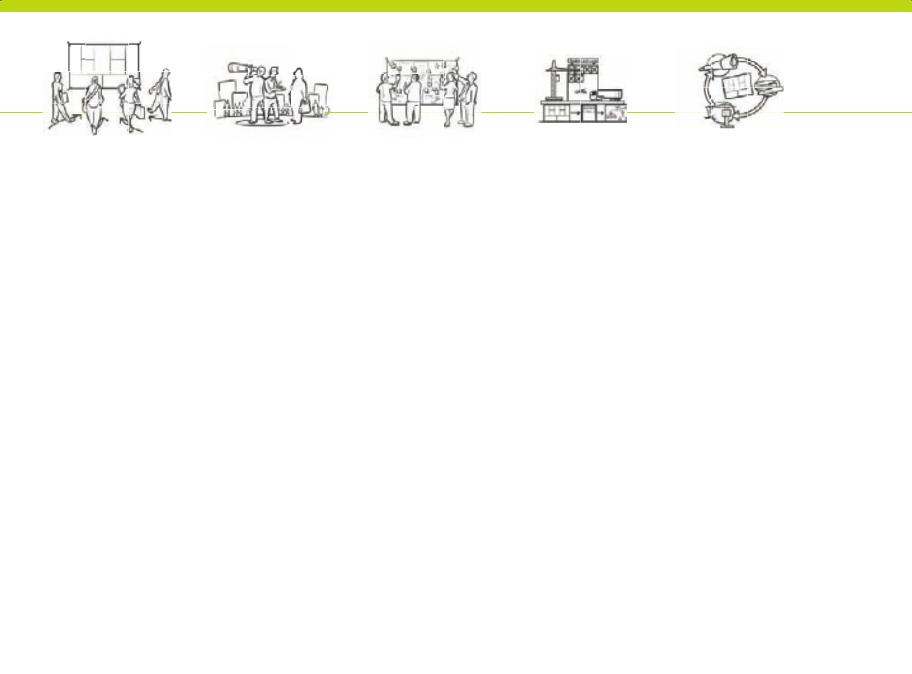
Mobilize |
Understand |
|
Prepare for a successful |
Research and analyze |
|
business model design |
elements needed for the |
|
project |
business model design eΩort |
|
|
|
|
Setting the stage |
Immersion |
|
|
|
|
Assemble all the elements for |
You and the business model |
|
successful business model design. |
design team immerse yourselves |
|
Create awareness of the need for a |
in relevant knowledge: custom- |
|
new business model, describe the |
ers, technology, and environment. |
|
motivation behind the project, and |
You collect information, interview |
|
establish a common language to |
experts, study potential cus- |
|
describe, design, and analyze and |
tomers, and identify needs and |
|
discuss business models. |
problems. |
|
|
|
|
• Business Model Canvas (p. 44) |
• Business Model Canvas (p. 44) |
|
• Storytelling (p. 170) |
• Business Model Patterns (p. 52) |
|
|
• Customer Insights (p. 126) |
|
|
• Visual Thinking (p. 146) |
|
|
• Scenarios (p. 180) |
|
|
• Business Model Environment (p. 200) |
|
|
• Evaluating Business Models (p. 212) |
|
Design |
Implement |
Manage |
|
|||
Generate and test viable |
|
Implement the |
|
Adapt and modify the |
|
|
business model options, |
|
business model prototype |
|
business model in response |
|
|
and select the best |
|
in the field |
|
to market reaction |
|
|
|
|
|
|
|
|
|
Inquiry |
|
Execution |
|
Evolution |
|
|
|
|
|
|
|
|
|
Transform the information and |
|
Implement the selected business |
|
Set up the management struc- |
|
|
ideas from the previous phase |
|
model design. |
|
tures to continuously monitor, |
|
|
into business model prototypes |
|
|
|
evaluate, and adapt or transform |
|
|
that can be explored and tested. |
|
|
|
your business model. |
|
|
After an intensive business model |
|
|
249 |
|
||
|
|
|
||||
|
|
|
||||
inquiry, select the most satisfac- |
|
|
|
|
|
|
tory business model design. |
|
|
|
|
|
|
|
|
|
|
|
|
|
• Business Model Canvas (p. 44) |
|
• Business Model Canvas (p. 44) |
|
• Business Model Canvas (p. 44) |
|
|
• Business Model Patterns (p. 52) |
|
• Visual Thinking (p. 146) |
|
• Visual Thinking (p. 146) |
|
|
• Ideation (p. 134) |
|
• Storytelling (p. 170) |
|
• Scenarios (p. 180) |
|
|
• Visual Thinking (p. 146) |
|
• Managing Multiple Business Models |
|
• Business Model Environment (p. 200) |
|
|
• Prototyping (p. 160) |
|
(p. 232) |
|
• Evaluating Business Models (p. 212) |
|
|
|
|
|
|
|||
• Scenarios (p. 180) |
|
|
|
|
|
|
• Evaluating Business Models (p. 212) |
|
|
|
|
|
|
• Business Model Perspective |
|
|
|
|
|
|
on Blue Ocean Strategy (p. 226) |
|
|
|
|
|
|
• Managing Multiple Business Models |
|
|
|
|
|
|
(p. 232) |
|
|
|
|
|
|
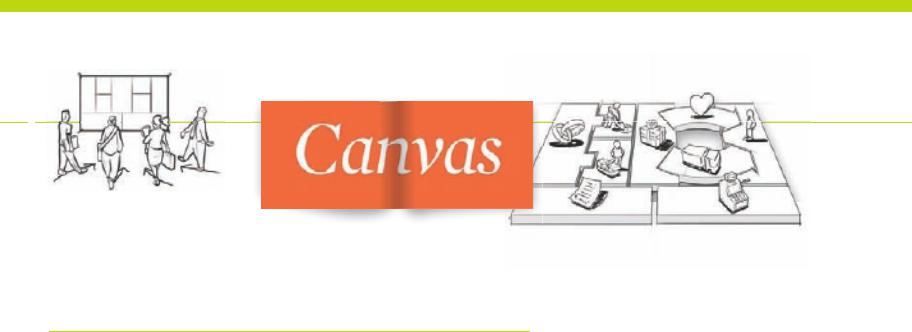
1
2
3
4
5
Mobilize
Prepare for a successful business model design project
|
activities |
critical success factors |
key dangers |
|
|
|
|
|
|
|
250 • Frame project objectives |
• Appropriate people, experience, |
• Overestimating value of initial idea(s) |
|
|
||||
• Test preliminary business ideas |
and knowledge |
|
|
• Plan |
|
• Assemble team |
|
|
The main activities of this first phase are framing the project objec- |
|
tives, testing preliminary ideas, planning the project, and assembling |
|
the team. |
|
How objectives are framed will vary depending on the project, but |
|
this usually covers establishing the rationale, project scope, and |
|
main objectives. Initial planning should cover the first phases of a |
|
business model design project: Mobilize, Understand, and Design. |
|
The Implementation and Management phases depend heavily on |
|
the outcome of these first three phases—namely the business model |
|
direction—and therefore can only be planned later. |
Crucial activities in this first phase include assembling the project team and gaining access to the right people and information. While there are no rules about training the perfect team—again, each project is unique—it makes sense to seek a mix of people with broad management and industry experience, fresh ideas, the right personal networks, and a deep commitment to business model innovation. You may want to start doing some preliminary testing of the basic business idea during the mobilization phase. But since the potential of a business idea depends heavily on the choice of the right business model, this is easier said than done. When Skype launched its business, who would have imagined it would become the world’s largest long-distance call carrier?
In any case, establish the Business Model Canvas as the shared language of the design effort. This will help you structure and present preliminary ideas more effectively and improve communications. You may also want to try weaving your business model ideas into some stories to test them.
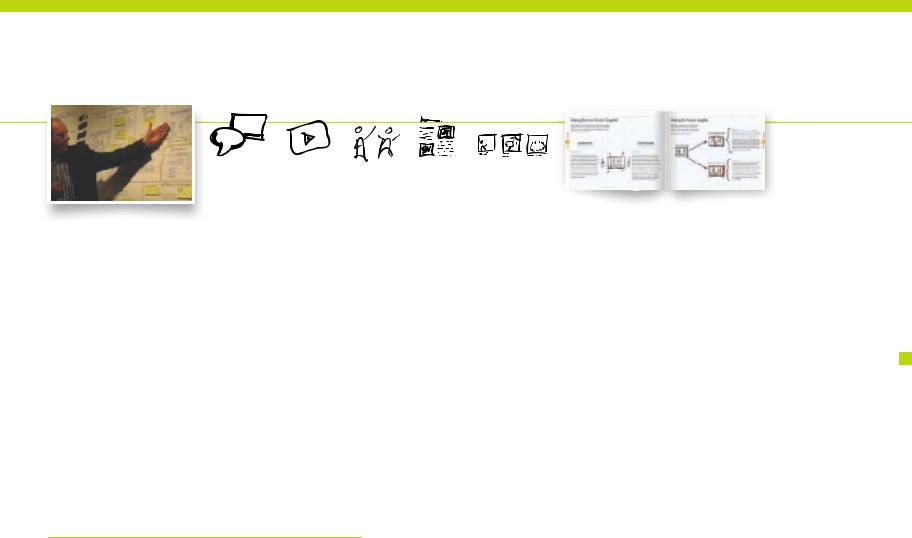
One clear danger in the Mobilization phase is that people tend to overestimate the potential of initial business model ideas. This can lead to a closed mindset and limited exploration of other possibilities. Try to mitigate this risk by continuously testing the new ideas with people from varied backgrounds. You may also want to consider organizing a so-called kill/thrill session in which all participants
are tasked first with brainstorming for 20 minutes on reasons why the idea won’t work (the “kill” portion), then spend 20 minutes brainstorming exclusively on why the idea will fly (the “thrill” portion). It’s a powerful way to challenge an idea’s fundamental worth.
Working from the Established Company Perspective
} Project legitimacy Building project legitimacy is a critical success factor when working within established organizations. Since business model design projects affect people across organizational boundaries, a strong and visible commitment by the board and/or top management is indispensable to obtaining
cooperation. A straightforward way to create legitimacy and visible sponsorship is to directly |
|
involve a respected member of top management from the very beginning. |
251 |
}Manage vested interests Take care to identify and manage vested interests throughout the organization. Not everybody in an organization is interested in reinventing the current business model. In fact, the design effort may threaten some people.
}Cross-functional team As described previously (see p. 143), the ideal business model task force is composed of people from across the organization, including different business units, business functions (e.g. marketing, finance, IT), levels of seniority and expertise, and so forth. Different organizational perspectives help generate better ideas, and increase the likelihood that the project will succeed. A cross-functional team helps identify and overcome potential obstacles to reinvention early in the game and encourages buy-in.
}Orienting decision makers You should plan on spending a considerable amount of time orienting and educating decision makers on business models, their importance, and the design and innovation process. This is critical to gaining buy-in and overcoming resistance to the unknown or not-yet-understood. Depending on your organization’s management style you may want to avoid overemphasizing the conceptual aspects of business models. Stay practical and deliver your message with stories and images rather than concepts and theory.

1
2
3
4
5
Understandi
Research and analyze the elements needed for the business model design effort
activities
252• Scan environment
•Study potential customers
•Interview experts
•Research what has already been tried (e.g. examples of failures and their causes)
•Collect ideas and opinions
critical success factors |
|
key dangers |
|
|
|
• Deep understanding of potential |
|
• Over-researching: disconnect |
target markets |
|
between research and objectives |
• Looking beyond the traditional |
|
• Biased research because of precom- |
boundaries defining target markets |
|
mitment to a certain business idea |
Scanning, though, is inevitably accompanied by the risk of overresearching. Make your team aware of this risk at the outset and ensure that everyone agrees to avoid excessive researching. “Analysis paralysis” can also be avoided by prototyping business models early on (see Prototyping, p. 160). This has the added benefit of allowing you to quickly collect feedback. As mentioned earlier, research, understanding, and designing go hand in hand, and the boundaries separating them are often unclear.
This second phase consists of developing a good understanding of the context in which the business model will evolve.
Scanning the business model environment is a mix of activities, including market research, studying and involving customers, interviewing domain experts, and sketching out competitor business models. The project team should immerse itself in the necessary materials and activities to develop a deep understanding of the business model “design space.”
During research, one area that deserves careful attention is developing deep knowledge of the customer. This sounds obvious, but it is often neglected, particularly in technology-focused projects. The Customer Empathy Map (see p. 131) can serve as a powerful tool to help you structure customer research. One common challenge is that the Customer Segment is not necessarily clear from the outset. A technology “still in search of a problem to solve” may be applicable in several different markets.
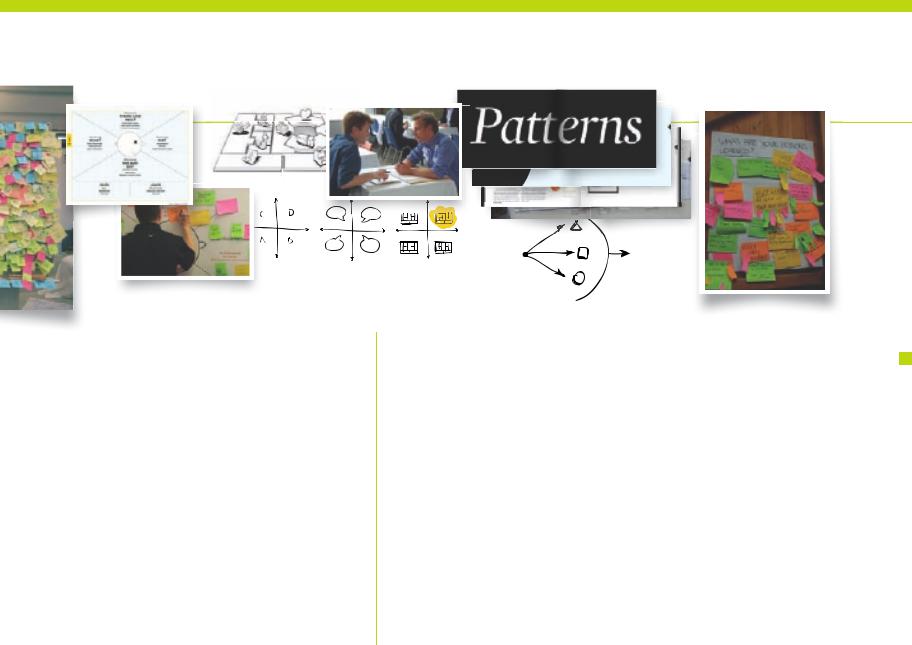
A critical success factor in this phase is questioning industry assumptions and established business model patterns. The game console industry was building and selling cutting edge subsidized consoles until the Nintendo Wii overturned commonly accepted assumptions (see p. 82). Questioning assumptions includes exploring the potential of “the low end” of established markets, as Scott Anthony points out in The Silver Lining. As you scan
the environment and assess trends, markets, and competitors, remember that the seeds of business model innovation can be found just about anywhere.
During the Understanding phase you should also actively seek input from varied sources, including customers. Start testing preliminary business model directions early by soliciting feedback on Business Model Canvas sketches. Bear in mind, though, that breakthrough ideas may encounter strong resistance.
|
|
|
Directions |
INFORMED |
|
|
DESIGN |
|
|
|
|
Working from the Established Company Perspective |
|
} Mapping/assessing existing business models Established organizations start with existing |
253 |
business models. Ideally, mapping and assessing your current business model should be done in separate workshops involving people throughout the organization, at the same time ideas and opinions for new business models are being collected. This will provide multiple perspectives on the strengths and weaknesses of your business model, and provide the first ideas for new models.
}Looking beyond the status-quo It is particularly challenging to see beyond the current business model and business model patterns. Because the status quo is usually the result of a successful past, it is deeply embedded in organizational culture.
}Searching beyond the existing client base Searching beyond your existing client base is critical when seeking lucrative new business models. Tomorrow’s profit potential may well lie elsewhere.
}Demonstrate progress Excessive analysis risks losing senior management support due to a perceived lack of productivity. Demonstrate your progress by describing customer insights or showing a series of business model sketches based on what you’ve learned from research.
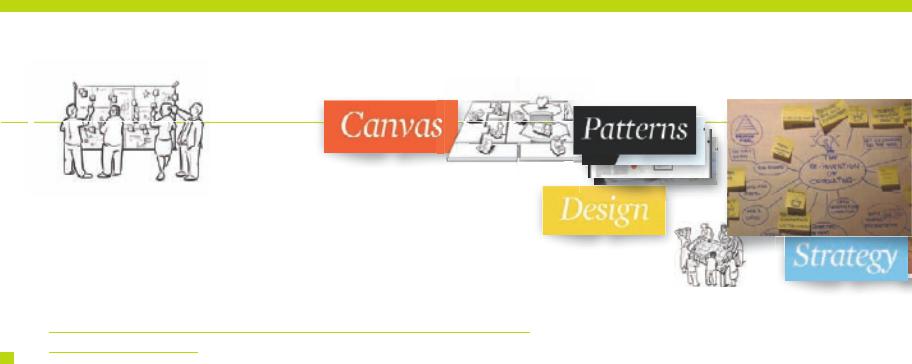
1
2
3
4
5
Design
Adapt and modify the business model in response to market response
activities
254• Brainstorm
•Prototype
•Test
•Select
critical success factors |
key dangers |
|
|
• Co-create with people from across |
• Watering down or suppressing |
the organization |
bold ideas |
• Ability to see beyond status quo |
• Falling in love with ideas too quickly |
• Taking time to explore multiple |
|
business model ideas |
|
The key challenge during the Design phase is to generate and stick with bold new models. Expansive thinking is the critical success factor here. In order to generate breakthrough ideas, team members must develop the ability to abandon the status quo (current business models and patterns) during ideation. An inquiry-focused design attitude is also crucial. Teams must take the time to explore multiple ideas, because the process of exploring different paths is most likely to yield the best alternatives.
Avoid “falling in love” with ideas too early. Take the time to think through multiple business model options before selecting the one you want to implement. Experiment with different partnership models,
seek alternative revenue streams, and explore the value of multiple distribution channels. Try out different business model patterns (see p. 52) to explore and test new possibilities.
To test potential business models with outside experts or prospective clients, develop a narrative for each and seek feedback on your telling of each model’s “story.” This is not to imply that you need to modify your model based on each and every comment. You will hear feedback such as “this won’t work, customers don’t need it,” “that’s not doable, it goes against industry logic,” or “the marketplace just isn’t ready.” Such comments indicate potential roadblocks ahead but should not be considered showstoppers. Further inquiry may well enable you to successfully refine your model.
Iqbal Quadir’s quest to bring mobile telephony to poor rural villagers in Bangladesh in the late 1990s provides a powerful example. Most
industry experts rejected his idea, saying poor villagers were pressed by more basic needs and wouldn’t pay for mobile telephones. But seeking feedback and developing contacts outside the telecommunications
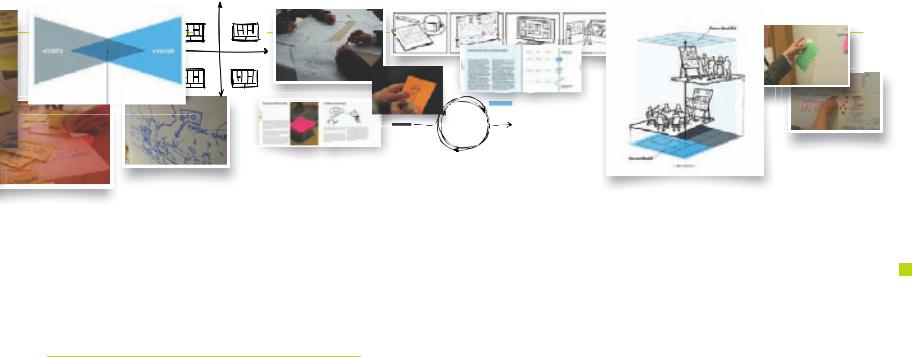
|
|
|
|
|
|
|
|
|
|
|
|
|
|
|
|
|
|
|
|
|
|
|
|
|
|
|
|
|
|
|
|
|
|
|
|
|
|
|
|
|
|
|
|
|
|
|
|
|
|
|
|
|
|
|
|
|
|
|
|
|
|
|
|
|
|
|
|
|
|
|
|
|
|
|
|
|
|
|
|
|
|
|
|
|
|
|
|
|
|
|
|
|
|
|
|
|
|
|
|
|
|
|
|
|
|
|
|
|
|
|
|
|
|
|
|
|
|
|
|
|
|
|
|
|
INQUIRY |
EXECUTE |
|
|
|
||
|
|
|
|
|
|
|
|
||||
|
|
|
|
|
|
|
|
|
|
|
|
provoke
industry led to a partnership with microfinance institution Grameen Bank, which became the cornerstone of Grameenphone’s business model. Contrary to expert opinion, poor villagers were indeed willing to pay for mobile connectivity, and Grameenphone became Bangladesh’s leading telecommunications provider.
Working from the Established Company Perspective
} Prevent taming of bold ideas Established organizations tend to water down bold business model ideas. Your challenge is to defend their boldness —while assuring that they won’t face overwhelming obstacles if implemented.
To achieve this tricky balance it can be helpful to draw a risk/reward profile of each model. The profile could include questions such as, What is the profit/loss potential? Describe potential conflicts with existing business units. How might this affect our brand? How will existing customers react? This approach can help you clarify and address the uncertainties in each model. The bolder the model, the higher the level of
uncertainty. If you clearly define the uncertainties involved (e.g. new pricing mechanisms, new Distribution Channels), you can prototype and test them in the market to better predict how the 255 model will perform when launched full-scale.
}Participatory design Another way to improve the likelihood of having bold ideas adopted and subsequently implemented is to be especially inclusive when assembling the design team. Cocreate with people from different business units, different levels of the organizational hierarchy, and different areas of expertise. By integrating comments and concerns from across the organization, your design can anticipate and possibly circumvent implementation roadblocks.
}Old versus new One big design question is whether the old and new business models should be separated or integrated into one. The right design choice will greatly affect chances of success (see Managing Multiple Business Models, p. 232).
}Avoid short-term focus One limitation to avoid is a short-term focus on ideas with large firstyear revenue potential. Big corporations, in particular, can experience huge absolute growth. A company with annual sales of U.S. $5 billion, for example, generates $200 million in new revenues by growing at the modest rate of four percent. Few breakthrough business models can achieve such revenues during their first year (doing so would require acquiring 1.6 million new customers, each paying an annual fee of $125). Therefore, a longer-term perspective is required when exploring new business models. Otherwise, your organization is likely to miss out on many future growth opportunities. How much do you imagine Google earned in its first year?
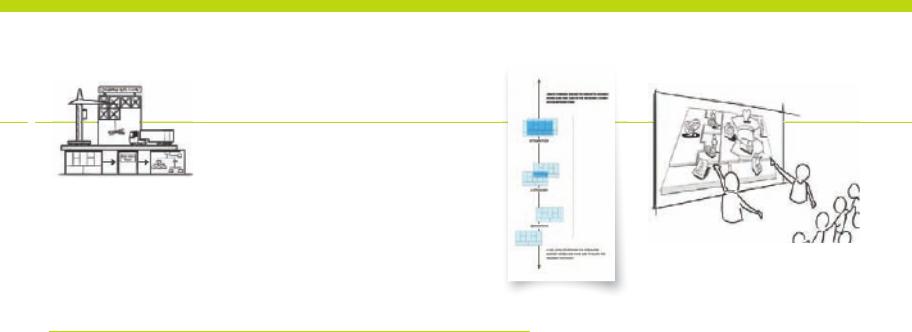
1
2
3
4
5
Implement
Implement the business model prototype in the field
|
activities |
critical success factors |
key dangers |
|
|
|
|
|
|
|
256 • Communicate and involve |
• Best practice project management |
• Weak or fading momentum |
|
|
||||
|
• Execute |
• Ability and willingness to rapidly |
|
|
|
|
|
adapt the business model |
|
|
|
|
• Align “old” and “new” business |
|
|
|
|
models |
|
Business Model Generation focuses on understanding and developing innovative business models, but we’d also like to offer some suggestions on implementing new business models, particularly within established organizations.
Once you’ve arrived at a final business model design, you will start translating this into an implementation design. This includes defining all related projects, specifying milestones, organizing any legal structures, preparing a detailed budget and project roadmap, and so forth. The implementation phase is often outlined in a business plan and itemized in a project management document.
Particular attention needs to be paid to managing uncertainties. This implies closely monitoring how risk/reward expectations play out against actual results. It also means developing mechanisms to quickly adapt your business model to market feedback.
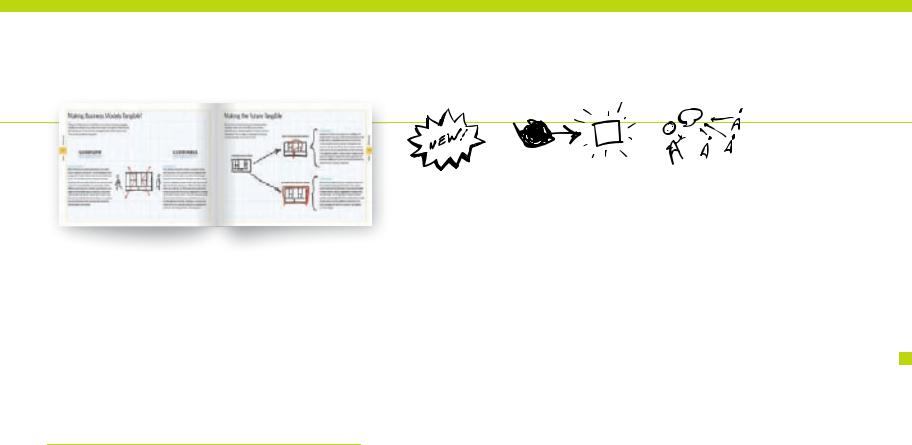
For example, when Skype started becoming successful and was signing up tens of thousands of new users each day, it had to immediately develop mechanisms to cost-effectively handle user feedback and complaints. Otherwise, skyrocketing expenses and user dissatisfaction would have brought the company to its knees.
Working from the Established Company Perspective
} Proactively managing “roadblocks” The single element that most increases the likelihood of a new business model’s success is in place long before actual implementation. By this we are referring to the participation of people from throughout the organization during the Mobilization, Understanding, and Design phases. Such a participatory approach will have already established buy-in and uncovered obstacles before the imple-
mentation of the new model is even planned. Deep, cross-functional participation allows you to directly address any concerns regarding the new business model before drawing the roadmap 257 for its implementation.
}Project sponsorship A second success element is the sustained and visible support of your project sponsor, something that signals the importance and legitimacy of the business model design effort. Both elements are crucial to keeping vested interests from undermining the successful implementation of a new business model.
}Old versus new business model A third element is creating the right organizational structure for your new business model (see Managing Multiple Business Models, p. 232). Should it be a standalone entity or a business unit within the parent organization? Will it draw on resources shared with an existing business model? Will it inherit the parent’s organizational culture?
}Communication campaign Finally, conduct a highly visible, multi-channel internal communication campaign announcing the new business model. This will help you counter “fear of the new” in your organization. As outlined earlier, stories and visualizations are powerful, engaging tools that help people understand the logic of and rationale for the new business model.
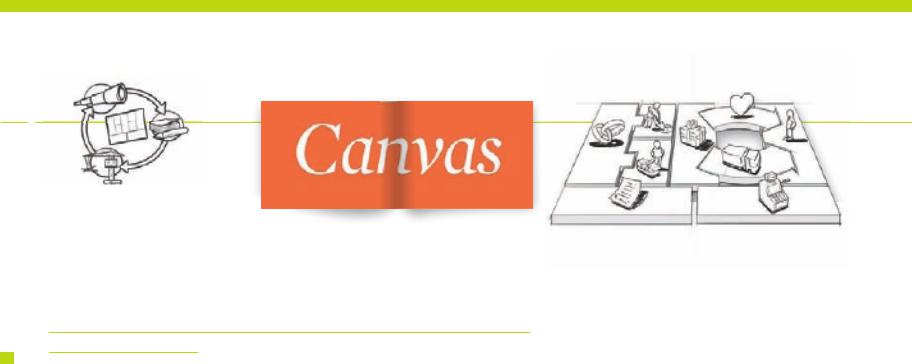
1
2
3
4
5
Manage
Adapt and modify the business model in response to market reaction
activities
258• Scan the environment
•Continuously assess your business model
•Rejuvenate or rethink your model
•Align business models throughout the enterprise
•Manage synergies or conflicts between models
critical success factors |
key dangers |
|
|
• Long-term perspective |
• Becoming a victim of your own |
• Proactiveness |
success, failing to adapt |
|
|
• Governance of business models |
|
For successful organizations, creating a new business model or rethinking an existing one is not a one-time exercise. It’s an activity that continues beyond implementation. The Manage phase includes continuously assessing the model and scanning the environment
to understand how it might be affected by external factors over the long term.
At least one person on the organizational strategy team—if not a new team—should be assigned responsibility for business models and their long-term evolution. Consider organizing regular workshops with cross-functional teams to evaluate your business model. This will help you judge whether a model needs minor adjustments or a complete overhaul.
Ideally, improving and rethinking the organization’s business model should be every employee’s obsession rather than something that preoccupies only top management. With the Business Model Canvas you now have a formidable tool with which to make business models clear to everybody throughout the enterprise. New business model ideas often emerge from unlikely places within an organization.
Proactive response to market evolutions is also increasingly important Consider managing a “portfolio” of business models. We live in the business model generation, a time when the shelf life of successful business models is shrinking quickly. As with traditional product life-
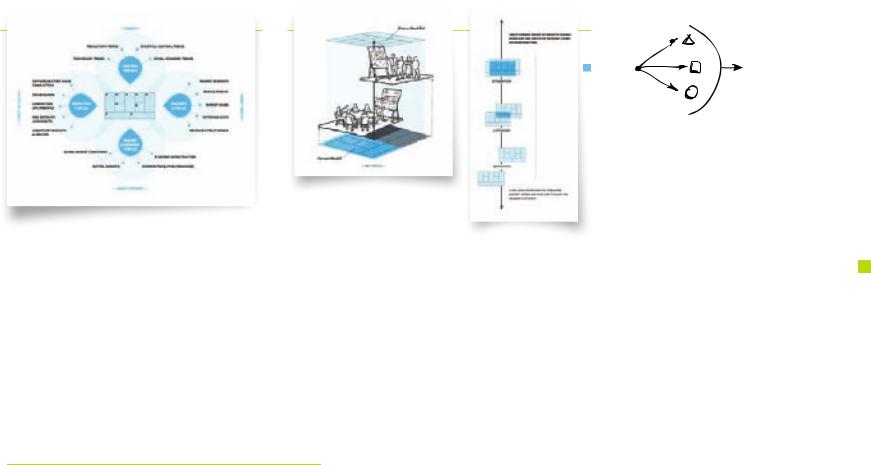
|
|
|
MAKE TANGIBLE |
|
|
irections |
INFORMED |
|
DESIGN |
cycle management, we all need to start thinking about replacing our current cash-generating business models with growth models for tomorrow’s marketplace.
Dell disrupted the PC industry when it introduced the build-to-order format and direct online sales. Over the years, Dell grew so successfully that it established itself as the industry leader. But the company failed to fully rethink its once disruptive business model. Now that the industry landscape has changed, Dell risks remaining stuck
in a commoditized PC market, while growth and profits, generated elsewhere, lie outside its reach.
Working from the Established Company Perspective
} Business Model Governance Consider establishing a “business model governance” authority to help better manage business models across the enterprise. This group’s role would be to orchestrate business models, engage stakeholders, launch inno-
vation or redesign projects, and track the overall evolution of the organization’s business mod-
els. It should also manage the “master” business model that describes the entire organization. 259 This master template could serve as the starting point for each business model project within
the organization. The master business model would also help different functional groups, such as operations, manufacturing, or sales align with the organization’s overarching goals.
}Manage synergies and conflicts One of the business model governance authority’s main tasks would be to align business models with each other to exploit synergies and avoid or manage conflicts. A Canvas document describing each business model in the organization would help illuminate the big picture and achieve better alignment.
}Business model portfolio Successful, established companies should proactively manage a “portfolio” of business models. Many formerly successful companies in the music, newspaper, and automotive industries failed to proactively examine their business models and slid into crisis as a result. A promising approach to avoiding this fate is to develop a portfolio of business models whereby cash-generating businesses finance business model experiments for the future.
}A beginner’s mindset Maintaining a beginner's mindset helps keep us from becoming victims of our own successes. We all need to constantly scan the landscape and continuously assess our own business models. Take a fresh look at your model regularly. You may need to overhaul a successful model sooner than you thought.

WhAT
ELSE?
260
Prototyping is potentially the most important part of the book and tools provided.
My reasoning is based upon the stress and resistance that established organizations are facing in the process of innovating their own business models. Therefore a very potent strategy is prototyping—in order to create buy-in processes needed.
Terje Sand, Norway
Typically when an organization looks at improving their business model, it is as a result of
gaps. Visualizing your current business model can demonstrate the logical gaps that exist and make them tangible as action items.
Ravila White, United States
In established companies, there are often ample physical "product ideas" that never get serious consideration because they don't immediately fit the prevailing business model.
Gert Steens, Netherlands
Do not get too attached to the first idea or implementation.
Build in feedback loops and monitor early warning signals to explicitly challenge your original concept and be willing and able to completely change it if required.
Erwin Fielt, Australia
The freemium business model as the reverse of insurance—insightful!
Makes me want to turn other models upside down!
Victor Lombardi, United States
A business model is the
"core content"
or the
"SHort StorY"
of the company (actual or prospective).
A business plan is the “guideline for the action” or the “full story.”
Fernando Saenz-Marrero, Spain
When I work with non-profits the first thing I tell them is that they in fact have a "business" (model) in that they must create and capture value, whether that value comes from donations, subscriptions, and so on.
Kim Korn, United States
Begin with the end in mind while taking the end client perspective.
Karl Burrow, Japan

It’s one thing to map out a Business Model Canvas. But for creating a business model that in itself is a breakthrough innovation, it is helpful to use tools used to create breakthrough innovation in other industries, such as in design.
Ellen Di Resta, United States
Aravind uses the Freemium Business Model to enable FREE eye surgery for the poor in India. Business model innovation can really make a difference!
Anders Sundelin, Sweden
I find that although most managers understand strategy concepts, they have a tough time applying these concepts at their level of the organization.
however, discussions about business models connect the high-level concepts to day-to-day decisionmaking. It's a great middle ground.
Bill Welter, United States
Personas,Scenarios,Visualization, Empathymaps,andsoonaretechniques thatIhaveusedsincethelate1990sin userexperiencetypeprojects.Inthelast fewyearsIhaveseenthattheyareincrediblyeffectiveatastrategy/businesslevel.
Eirik V Johnsen, Norway
If solving humanity’s current problems requires rethinking how value is generated and for whom, then business model innovation is the premier
tool to organize, communicate, and implement that new thinking.
Nabil Harfoush, Canada
I'm interested in hearing how people are integrating technology ideas into their models using the Canvas. We've explored adding it as a separate layer (above or below financial) but have now settled on integrating it as notes on each of the 9 key areas. From this we then step back and develop a separate integrated technology plan.
Rob Manson, Australia
YoUr
business
model
Is not YoUr
business
It’s a method of inquiry to help you understand what to do next. Testing and iteration is key.
Matthew Milan, Canada
Multi-sided platforms are actually rather easy at the business model level; the difficulty comes in execution: attracting the "subsidized side," pricing on both sides, vertical or horizontal integration, how to change the business model in step with the size of the market on each side.
Hampus Jakobsson, Sweden
business model innovation combines creativity with a structured approach—the best of both worlds.
Ziv Baida, Netherlands
Many of my clients do not have a holistic view of their business model and tend to focus on trying to address the immediate problem. The Business Model Canvas provides a framework that helps clarify the why, who, what, when, where, and how.
Patrick van Abbema, Canada
I love the idea of using these tools to design businesses and to tinker under the hood of
the engine of an organization.
Michael Anton Dila, Canada
There are thousands of business models to be investigated and many thousands of people who are interested in them.
Steven Devijver, Belgium
Simplicity is very important to explain the patterns and to trigger the nonprofessional's involvement in business innovation.
Gertjan Verstoep, Netherlands
We have been working too long and too hard for companies with bad or improper business models.
Lytton He, China
The term business model is thrown around a lot and more frequently than not to mean an incomplete understanding of what makes a business a business (mostly just the financial/revenue aspect).
Livia Labate, United States
Business model innovation is one of the
LEAST uSED
& most powerful
ways to create sustainable profit |
261 |
growth, economic development and create new ‘markets’ and ‘industries’.
Deborah Mills-Scofield, United States
